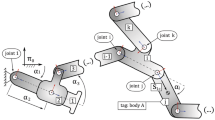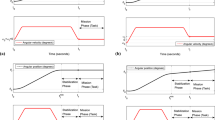Abstract
The results of the analytical and numerical solution of the problem of controlling the rotational motion of an axially symmetric rigid body with a combined performance index of the control process are presented using quaternions. The performance index includes the duration of the control, impulse of the squared angular momentum magnitude, and impulse of the magnitude of the control torque applied to the body. The control must take an axisymmetric rigid body from a state of rest to another state of rest.

Similar content being viewed by others
REFERENCES
F. Li and P. M. Bainum, “Numerical approach for solving rigid spacecraft minimum time attitude maneuvers,” J. Guidance, Contr., Dyn. 13 (1) (1990).
V. N. Branets and I. P. Shmyglevskii, Application of Quaternions in Problems of Orientation of a Rigid Body (Nauka, Moscow, 1973) [in Russian].
A. V. Molodenkov and Ya. G. Sapunkov, “Analytical solution of the optimal slew problem for an axisymmetric spacecraft in the class of conical motions,” J. Comput. Syst. Sci. Int. 55, 969 (2016).
A. V. Molodenkov and Ya. G. Sapunkov, “Analytical solution of the minimum time slew maneuver problem for an axially symmetric spacecraft in the class of conical motions,” J. Comput. Syst. Sci. Int. 57, 302 (2018).
M. V. Levskii, “Pontryagin’s maximum principle in optimal control problems of orientation of a spacecraft,” J. Comput. Syst. Sci. Int. 47, 974 (2008).
A. V. Molodenkov and Ya. G. Sapunkov, “Optimal control of rigid body’s rotation movement with a combined quality criterion,” J. Comput. Syst. Sci. Int. 58, 382 (2019).
Ya. G. Sapunkov and A. V. Molodenkov, “The investigation of characteristics of distant sounding system of the Earth with the help of cosmic device,” Mekhatron., Avtomatiz., Upravl., No. 6, (2008).
V. N. Branets, M. B. Chertok, and Yu. V. Kaznacheev, “Optimal rotation of a solid with one axis of symmetry,” Kosm. Issled. 22 (3) (1984).
M. V. Levskii, “Quadratic optimal control in reorienting a spacecraft in a fixed time period in a dynamic problem statement,” J. Comput. Syst. Sci. Int. 57, 131 (2018).
M. V. Levskii, “Analytic controlling reorientation of a spacecraft using a combined criterion of optimality,” J. Comput. Syst. Sci. Int. 57, 283 (2018).
L. S. Pontryagin, V. G. Boltyanskii, R. V. Gamkrelidze, and E. F. Mishchenko, The Mathematical Theory of Optimal Processes (Nauka, Moscow, 1961; Wiley, New York, London, 1962).
M. D. Griffin and J. R. French, Space Vehicle Design,AIAA Education Series (Reston, Virginia, 2004).
Funding
This work was supported by the Russian Foundation for Basic Research, project no. 19-01-00205.
Author information
Authors and Affiliations
Corresponding author
Additional information
Translated by A. Klimontovich
Rights and permissions
About this article
Cite this article
Molodenkov, A.V., Sapunkov, Y.G. Analytical Quasi-Optimal Solution of the Slew Problem for an Axially Symmetric Rigid Body with a Combined Performance Index. J. Comput. Syst. Sci. Int. 59, 347–357 (2020). https://doi.org/10.1134/S1064230720030107
Received:
Revised:
Accepted:
Published:
Issue Date:
DOI: https://doi.org/10.1134/S1064230720030107




